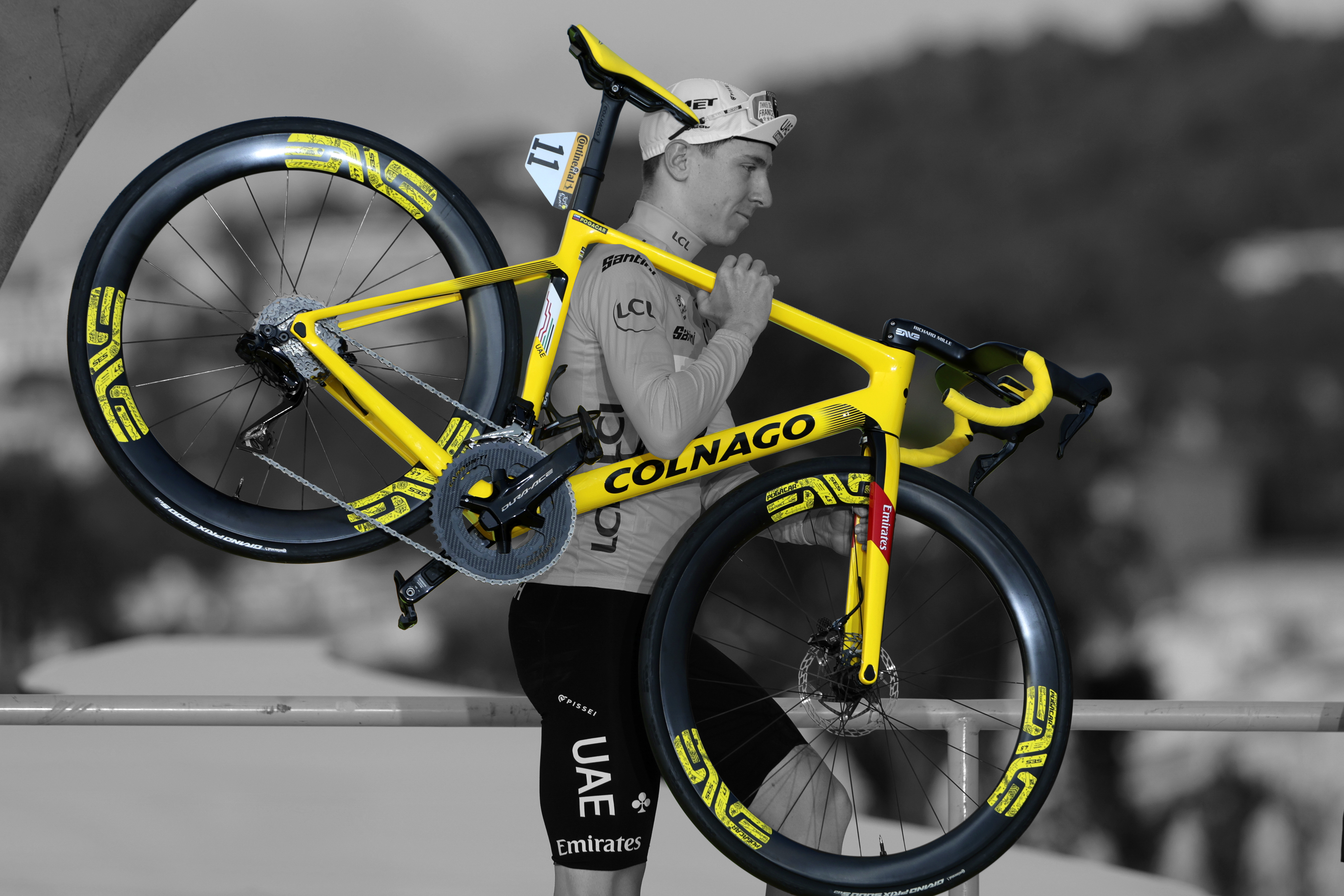
With such fine margins between winning and losing, it's no surprise that cyclists in the Tour de France race on the very best bikes available. One of the perks of being a professional cyclist is getting to ride the best road bikes in the world and have them maintained to perfection by professional mechanics.
Top-end road bikes cost a lot these days, but just how expensive are they?
While we dive into a few specific team examples here, if you want to see a full rundown of each team's equipment for the 2025 race, we'll have a Tour de France bikes guide later this week. Alternatively, if you want to know more about the teams in general, check out our Tour de France teams guide, where we discuss leaders, domestiques and more.
Naturally, the cost of different team bikes varies. Some teams ride off-the-shelf bikes and componentry that, stock-dependent, you could add to an online shopping basket and order tomorrow. This may be a dangerous proposition if you are fired up after watching an afternoon's racing and feel like treating yourself!
Then there's the prototype and pro-only componentry that is issued to some teams, such as the crazy Factor bike that Jake Stewart rode at the recent Critérium du Dauphine. That's where things get a little trickier to work out.
But all products used in the Tour de France must be made available to the public within 12 months, so there'll never be a bike you can't ride yourself. However, there are no rules on making it so insanely expensive that nobody in their right mind would actually buy it.
Within the 2025 Tour de France, there are 21 different bike brands, each will have a slightly different pricing structure for its range of bikes. There are also two brands that supply two teams each. Those brands are Canyon, which sponsors Movistar and Alpecin-Deceuninck, and Specialized, which supplies Soudal-QuickStep and Red Bull-Bora-Hansgrohe.
If you're after a ballpark figure for the bikes being raced in the Tour. The cost of a team race bike is in the region of £9,000 - £14,000 / €10k - €15k / $11k - $16k / AU$17k - $22k.
But let's take a deeper dive into the cost of some specific Tour de France bikes, including the super expensive time trial bike class. We'll also look at who exactly pays for the bikes, whether riders get to keep their own bike, and how many bikes a team will take to the race.
Tour de France bike cost breakdown
Firstly, it's important to recognise that a bike is made up of various components. Starting with the frame and fork, there is then a groupset (aka the gear and brake system), wheels, tyres, cockpit components such as the handlebar and stem, and the finishing kit such as the saddle, bar tape and pedals. There are then the small parts such as the bolts, bearings, inner tubes or tubeless sealant, lubricants, and even the paint. To quantify the cost of the bike as a whole, you need to calculate the sum of its parts.
It's also worth remembering that, depending on the terrain of the stage ahead, riders will often ride different frames or use different components to improve the bike's suitability to the course. Lighter wheels might be swapped in for mountainous stages; more aerodynamic wheels will be used for flatter days, and more puncture-proof tyres might be used if there are cobbled roads or poor road surfaces during a particular stage.
To calculate the true retail cost of a Tour de France bike, we've picked a few bikes being used this year and broken down the cost of each. We've looked at some of the most well-known and popular bikes in the race, as well as a relative newcomer to the WorldTour peloton, which, to a degree, bucks the hyper-expensive trend.
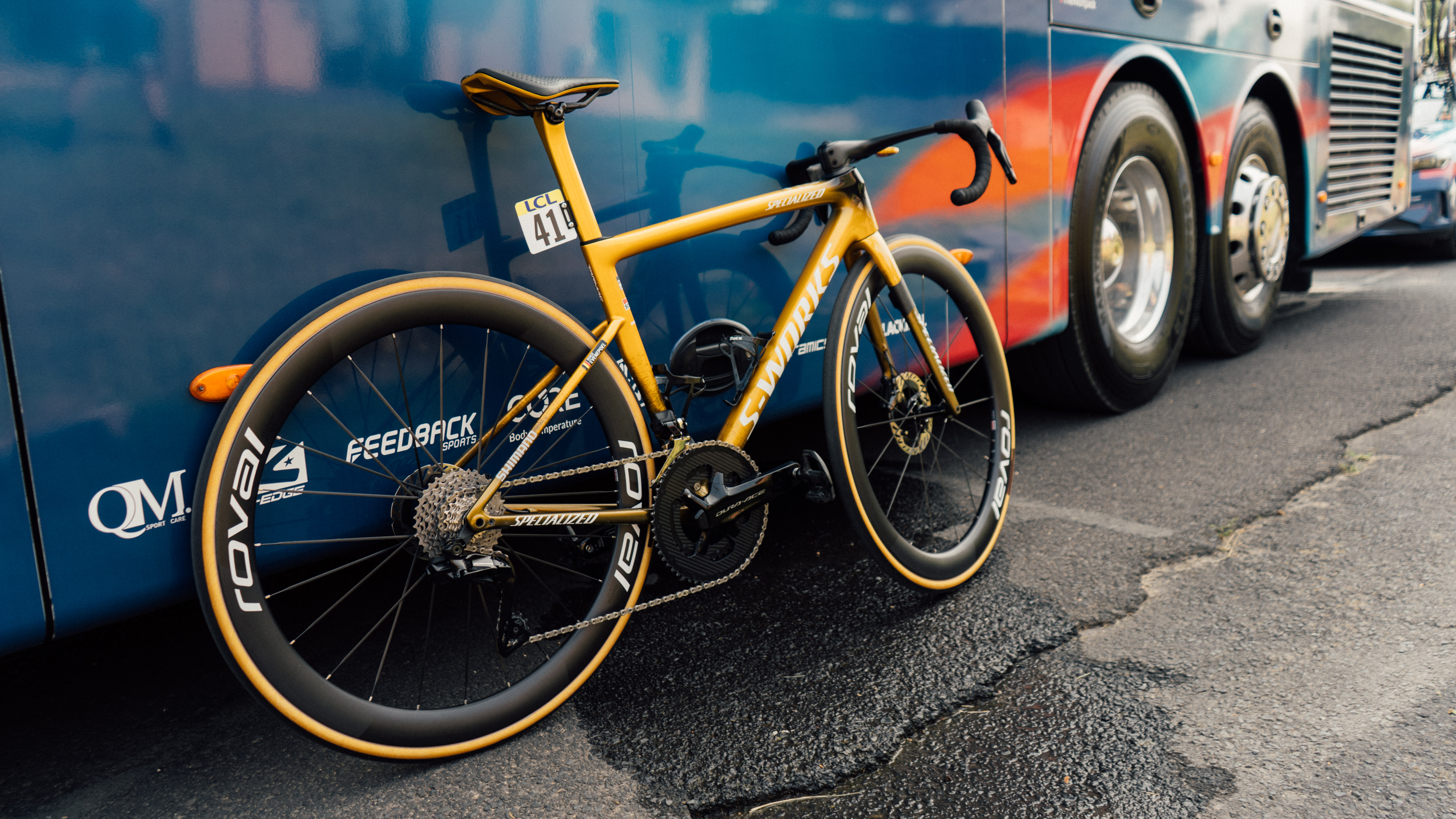
Soudal-QuickStep's Specialized S-Works Tarmac SL8
Belgian squad Soudal-QuickStep - or the 'Wolfpack' as they like to be known - race on the Specialized S-Works Tarmac SL8. It's fairly easy to work out the team bike cost as a lot of the components come from Specialized itself or its subsidiary wheel brand Roval, and are easily available to purchase online and in stores.
Interestingly, and very unusually, when the SL8 launched in 2023, it was cheaper than the outgoing SL7 model it replaced. This was a reflection of the impact COVID-19 had on the price of bikes, which by then had begun settling down.
The 'S-Works' name refers to Specialized's top spec frames, and if you want to ride the same bike as the pros, you'll need to spend some extra cash for this model over the regular Tarmac SL8.
Aside from the paint job, which is specific to Evenepoel, the S-Works Tarmac SL8 can be ordered from the brand's website for £12,000 / $12,999 / €14,000.00 / AU$17,999.99 with the same Shimano Dura-Ace groupset, Roval Rapide carbon fibre integrated handlebar, seatpost and tyres the team normally.
There are a few components used here by Evenepoel, however, that aren't included on this stock bike.
First, whereas the bike comes with Roval's Rapide CLX II wheels, he's got the newer Rapide CLX III wheels. At retail, this is a £500 ($600 / €800 / AU$600) upcharge, but expect that in the next few months the new wheels will roll out onto stock bikes.
Next, the stock bike comes with a high-end S-Works Power saddle, but Evenepoel takes it one step further by using a Power Evo saddle with a 3D printed upper. At retail, this is priced at £379, or a premium of around £120 over the stock saddle.
Third, Evenepoel has swapped out the Shimano Dura-Ace chainrings for a carbon fibre duo from CarbonTi. These are made in Italy and are priced at between €186 and €300 per chainring, depending on size. Assuming he's using a 54/40 combination, that's an upcharge of €435.
Connected to this, Cyclingnews understands that Soudal QuickStep use chains supplied by CeramicSpeed, which have been treated with a low-friction wax, rather than the more standard oil-based lubricant you might find on a stock chain. Sticking with Euros, as per CarbonTi above, that's €169 per chain.
And finally, there are a few accessories: there's a pair of Tacx Ciro bottle cages, priced at £15 each, plus a K-Edge computer mount and chain keeper, which together total £130.
Approx total cost: £13,300 / €15,700 / $14,500 / AU$20,000 with some approximate currency conversion and rounding.
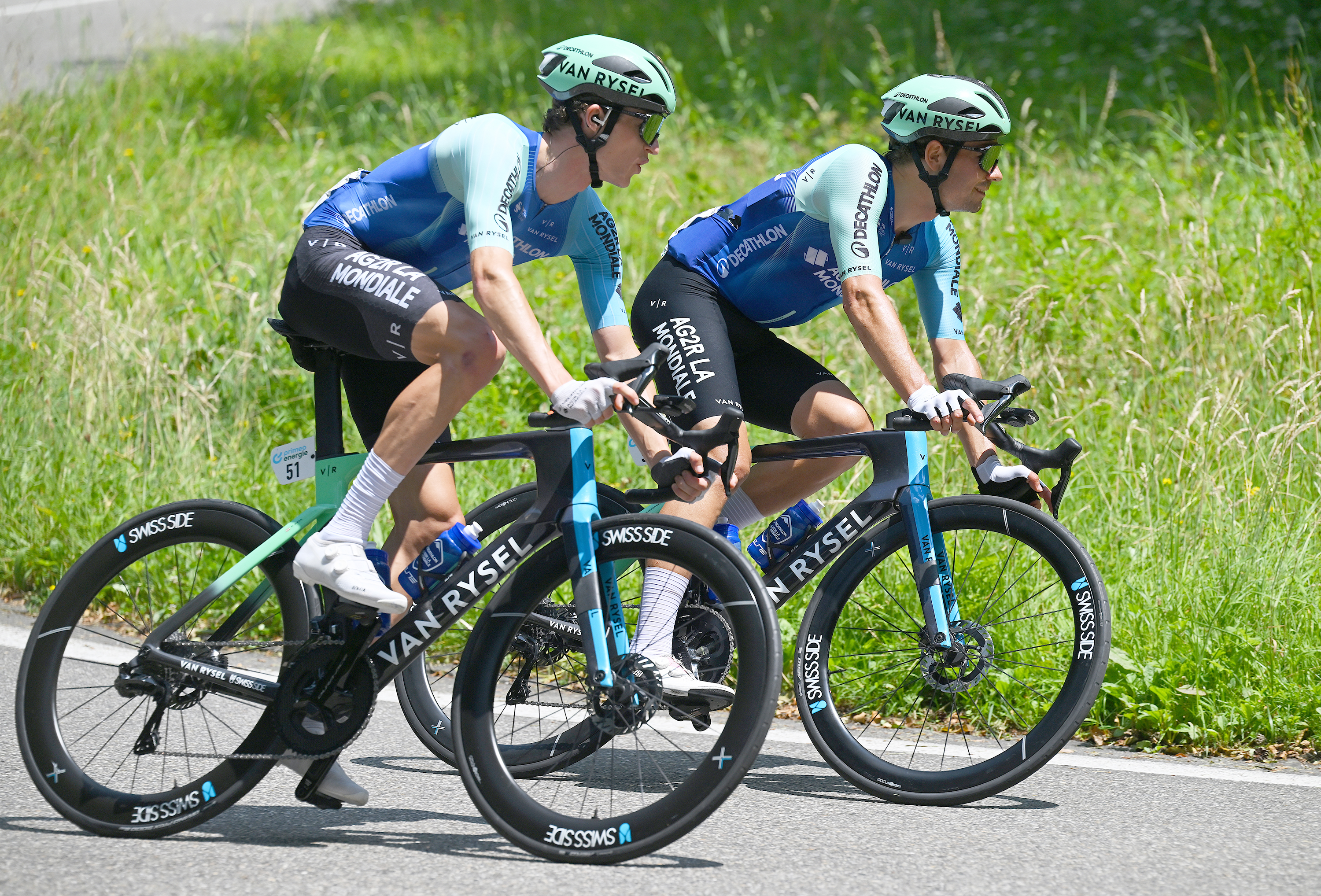
The cheapest Tour de France bike? Decathlon–AG2R La Mondiale's Van Rysel RCR-R
The French team Decathlon AG2R La Mondiale ride bikes from the Decathlon subsidiary brand, Van Rysel, with Shimano groupsets and Swiss Side wheels.
They have two road bikes available to them: the RCR-R, which is more of a lightweight, semi-aero all-rounder, which will be used on climbing stages; and the RCR-F, which is the dedicated aero machine reserved for flatter days.
They are some of the cheapest bikes in the 2025 Tour de France. The RCR-R, for example, is available to buy in exactly the same spec as the team, complete with Continental's clever airflow-beating 'Aero 111' front tyre, for £9,000. Buy in Van Rysel's home country of France, and it's even cheaper at €7,998.99.
Despite this, our Wind Tunnel superbike test showed it holds its own against its pricier competitors, and the team's reformed fortunes since switching to the brand prove it's no slouch on the road either.
The team's bikes are built up using Shimano Dura-Ace electronic groupsets, and Swiss Side Hadron carbon wheels, albeit we've heard on good authority that they'll be using a new set when the race starts in Lille. They also use Continental's GP5000 tubeless tyres, and the bikes are fitted with integrated bar-stem cockpits from Italian brand Deda.
The only extras on top of the base level bike are the inclusion of bottle cages at approx £50 for a pair, a computer mount for about the same, and we presume a waxed chain similar to Soudal-QuickStep above. Let's call it a rough £173 / $235 / €200 on top.
Approx total cost: £9,200 / €8,198.99 / $11,199 / AU$ NA
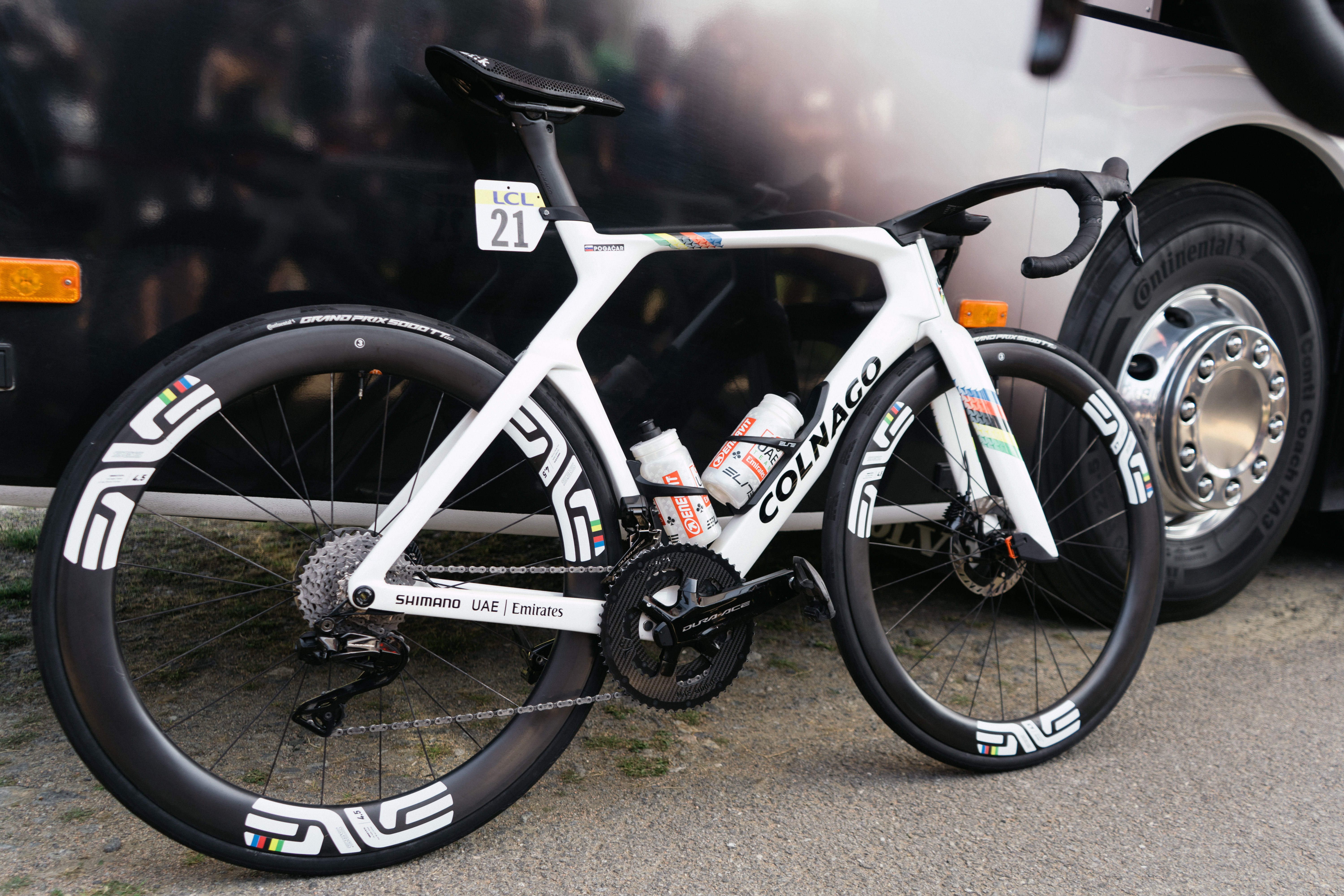
Tadej Pogačar's Colnago Y1RS
Tadej Pogačar is the overall race favourite in 2025, after dominating in 2024, having a storming Spring campaign, and winning the recent Critérium du Dauphiné against both of his main Tour de France competitors.
His UAE Team Emirates-XRG team races on Colnago bikes. He has the choice of the V5RS lightweight all-rounder and the crazy-looking Y1RS aero bike.
It isn't possible to purchase Pogačar's bike spec off the shelf, which means we have to get the calculator out to work out the cost.
You could buy the individual parts that make up the team's bike, and get close to the same build the team uses, even including the rainbow paint job, but there are a few things that mark Pogačar's bike as different.
On the Colnago website's bike builder, the closest you can get to the Slovenian ace's build comes out at £15,559 (Currency conversion = approx $21,300 / €18,100 / AUD $32,500)
This features the same frame, rainbow paintwork, and Dura-Ace electronic groupset. It comes with Enve's SES 4.5 wheels rather than the deeper 6.5s that will likely be used on this bike, but since they're a similar price, we'll ignore that here.
It lacks the power meter, though, and Pogacar runs different tyres, chainrings, disc rotors, derailleur hanger, pads, and a custom saddle.
At retail price, the cost difference for a Dura-Ace power meter chainset is approximately £600. The tyre cost difference is negligible. He's using the same chainrings as Remco Evenepoel above - albeit with his own 'TP' logo printed into them - so that's another €435. The X Rotor discs cost €185 each, and the AbsoluteBlack brake pads are €50 per wheel. He also uses a Frames and Gear aftermarket derailleur hanger, priced at £51.
Finally, there's the 3D printed, custom-moulded saddle, which at £499 per saddle, is an upcharge of £300 compared to the stock option.
There's also the additional cost of bar tape, computer mount, bottle cages, and the probable addition of ceramic bearings to add on. We'll estimate an approximate cost of around £200 for all that.
Adding all that together, with some currency conversion and rounding, gets us an approx total cost of £17,351 / $23,769 / €20,158 / AU$36,105.
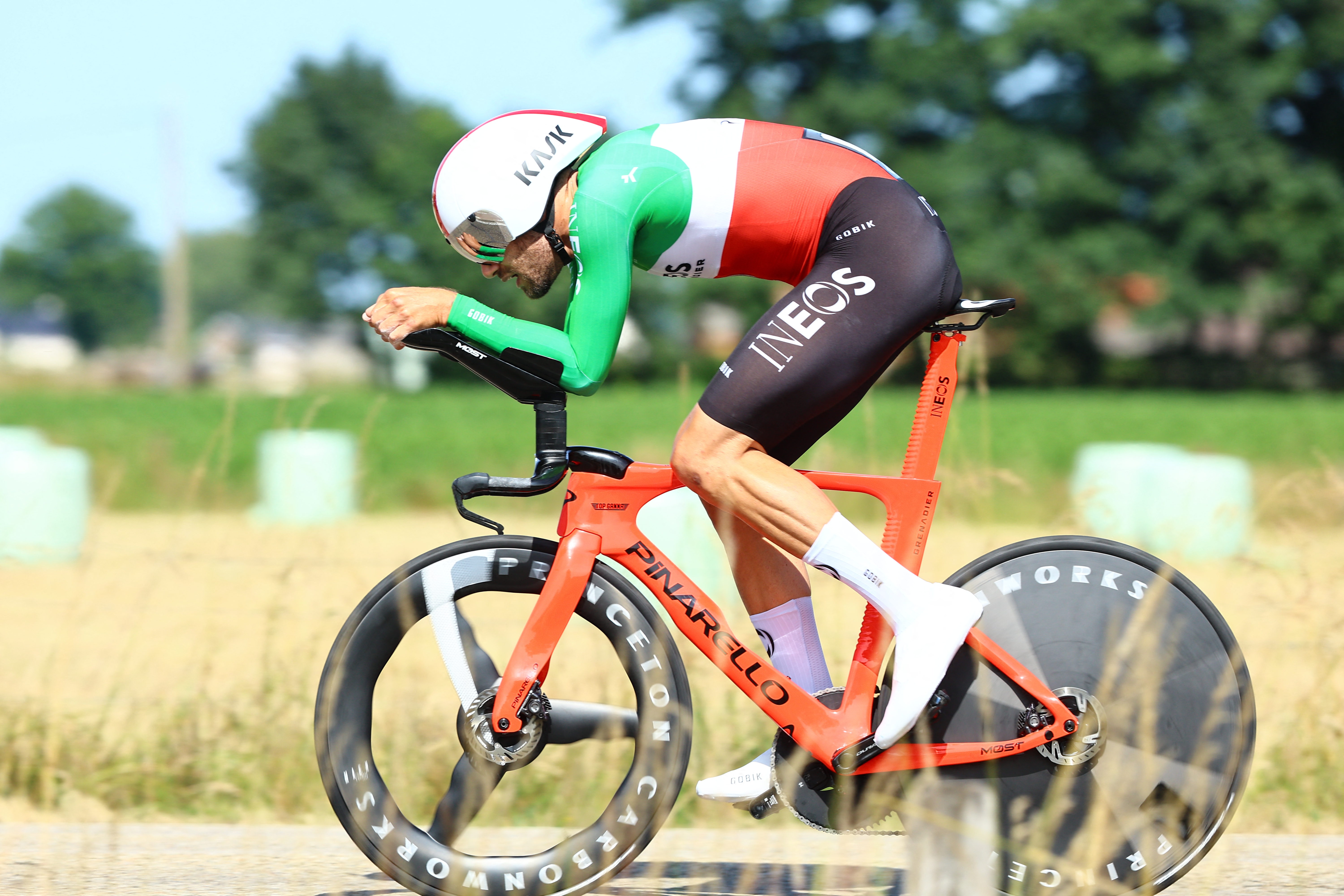
The most expensive Tour de France bike? Ineos Grenadiers' Pinarello Bolide F
There's no greater arms race in cycling than in the world of time trialling, and as such, it's here that the money really starts to stack up. Nowadays, we have a deep understanding of aerodynamics, rolling resistance and drivetrain efficiency, and how they all affect the speed at which a rider will travel for a set power. Therefore, the time and research going into developing time trial bikes, components, and clothing is growing exponentially as the available gains get smaller and smaller. The result is the cost of the products that are created are pretty damn expensive.
One such bike is the Pinarello Bolide F, launched in 2024 as a road-going version of the track bike that Ganna used to break the World Hour Record. It's such a unique bike that finding it available to buy online is tricky, but given the older 2022 model is priced at £12,000 for a frame alone or a staggering £30,000 with custom-printed time trial extensions (which Ganna will certainly have) it's safe to assume that this newer, higher-tech build is even more expensive.
On top of this, based on recent races, riders are likely to use a pair of wheels from Princeton Carbonworks: the Blur 633 V4 rear disc wheel ($2,950) and Mach 7580 TSV2 front tri-spoke ($2,850). Total cost $5,800 (Approximately £4,236 after conversion).
They'll also need a groupset, and it makes sense that they'll use the same Dura-Ace R9200 range as found on their road bikes. When factoring in a power meter, that'll cost in the region of £4,200, albeit with small differences based on the time-trial-specific brake levers and shifters. They'll also almost certainly swap the 2x chainset and front derailleur in favour of a single aero-optimised chainring. We calculate this to be around £200 cheaper than a 2x setup, so will deduct this from the total.
Beyond these main components, there are other 'finishing' components to add on. Continental GP5000 S TR tyres will cost £200 for a pair. We'll add another £50 as a rough estimate for bar tape, chain lube or wax, tubeless conversion, and there's a saddle to account for.
This season Ganna has used Prologo saddles. The brand recently unveiled a saddle at an incredible £1099, but it doesn't look as though Ganna is using it in the image above, so we'll settle on a safe £200 round figure.
We also acknowledge there may be new or secret prototype parts that we don't even know about yet, but this is a good estimation.
Approx total cost: £38,886
Approx currency conversion (June 2024): $53,200 / €45,200 / AU$81,000
Cost of Tour de France jersey or skinsuit
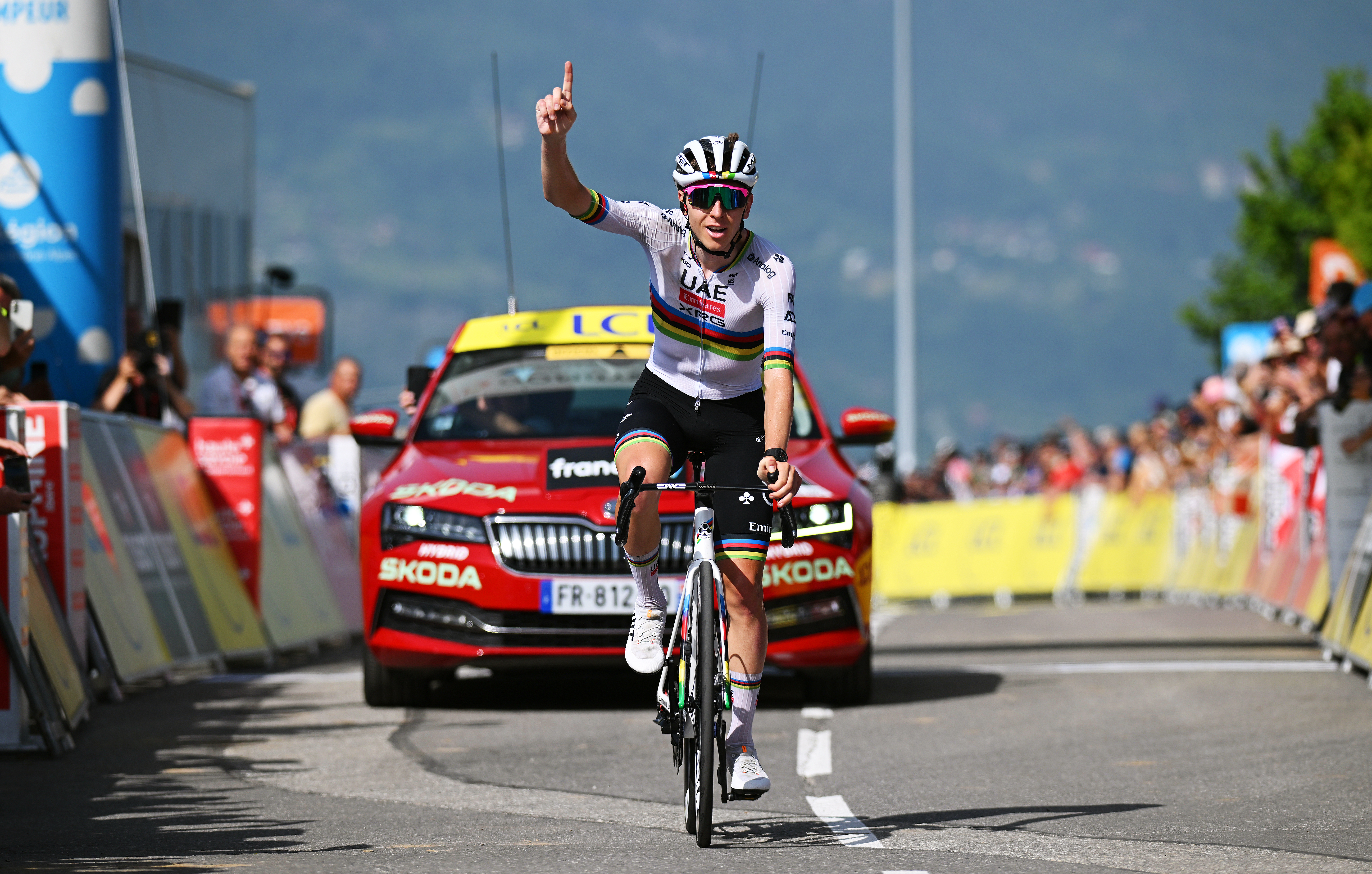
If you look at a rider front-on, the biggest part of the picture is not the bike, but the rider him/herself. This is important in the field of aerodynamics because it means the wind is actually hitting the rider more than the bike. The bike only accounts for around 20-30% of the puzzle.
Therefore, just as much - if not more - attention is paid to the clothing riders wear, and as such, the cost of a skinsuit worn by a rider in the Tour de France is equally eyewatering.
Some extreme examples we've covered in the past include a skinsuit worn by Mathieu van der Poel in 2022, which had a retail price of £2,750. Assos released a $7,000 skinsuit ahead of the Paris Olympics, and Mark Cavendish wore £1,000 aero socks, called the 'Project 35', ahead of his tilt at a 35th stage win.
The kit worn by most of the peloton on normal road stages is less ridiculous, but still quite pricey. Let's look at a few key names and run some sums.
Tadej Pogačar
I'll start with the race favourite. His skinsuit is likely custom-tailored to ensure the perfect fit, but in order to get a price more reflective of the average Tour rider, let's assume he gets an off-the-peg size.
Looking at his kit sponsor Pissei's website, they sell a replica short-sleeved skinsuit, complete with UAE Team Emirates design and rainbow colours, at £300. This isn't the exact design he used at the recent Critérium du Dauphiné (shown above) as the shoulders don't have the same aero trip strip finish, but it's a good ballpark comparison. Add to this £40 for his aero socks, and you're looking at £340 for his clothing. His Met Trenta 3K helmet is another £300, plus another £370 for his DMT Scarpe shoes, and he's rolling round in a smidge over £1000 worth of clothing. We won't add on the £250,000 Richard Mille watch he sometimes wears.
Total cost: £1010 (Conversion: $1380 / €1175 / AU$2100)
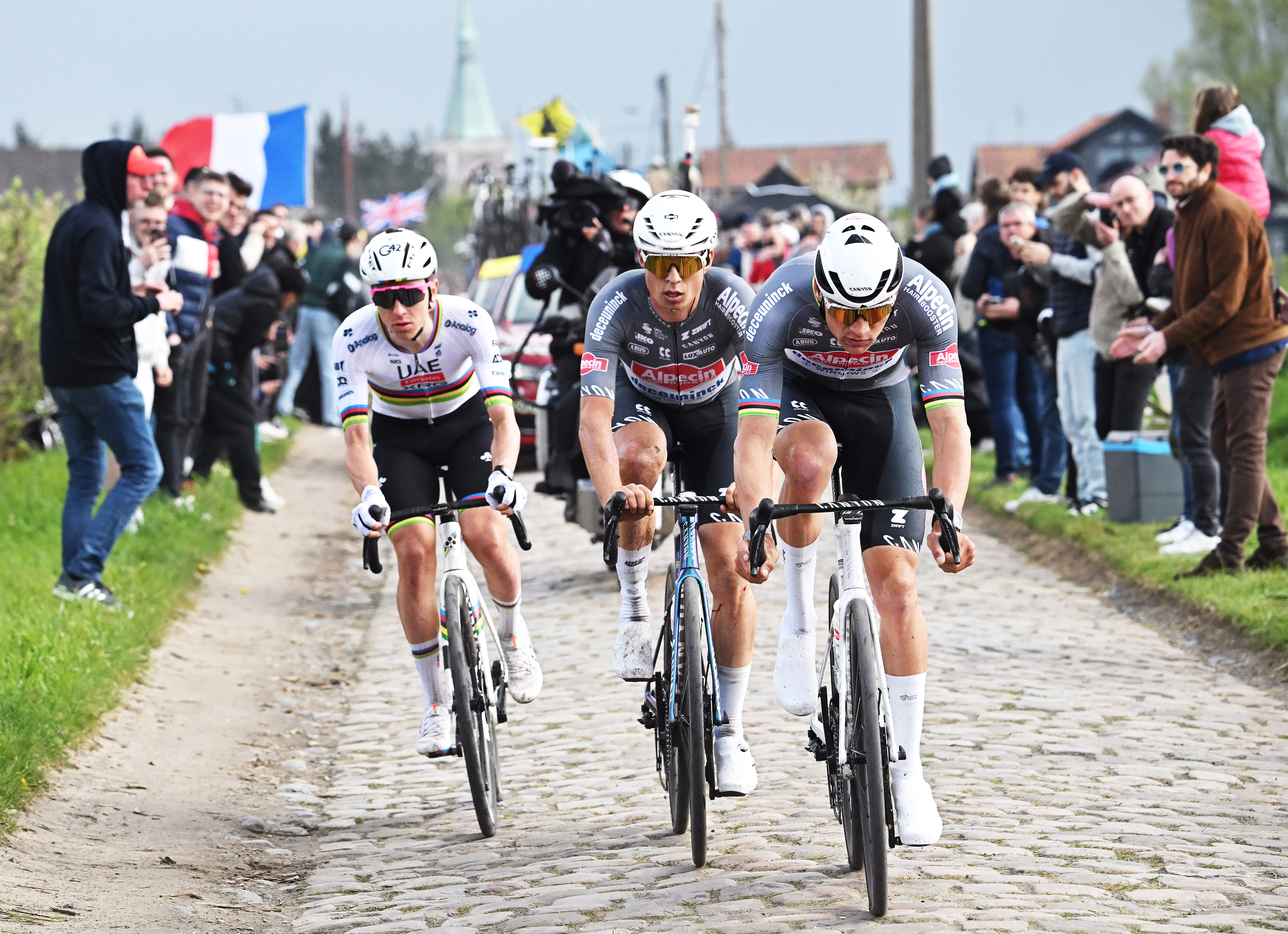
Jasper Philipsen
Next up, let's look at sprint sensation Jasper Philipsen (Alpecin-Deceuninck). Sponsored by Kalas, the Belgian will wear one of two skinsuits from his clothing sponsor Kalas, depending on the day. On hotter days, or on days where he's unlikely to sprint for the win, he'll wear the Kalas 'Passion Short Sleeve Brios' road race suit, priced at £239 off the shelf, or the similarly-priced 'Verano' suit.
We know this because we recently took a load of Kalas kit to the wind tunnel to see whether expensive kit makes you faster.
On sprint stages, where he's fighting for the win, he's likely to wear the fastest suit Kalas makes, the 'Project RR' designed in conjunction with Vorteq (the same Vorteq mentioned above). This is priced at £449 off the shelf (and climbs into the thousands if you get it custom fitted).
In addition, he tends to wear aero overshoes from AeroCyclingGear, which are actually quite well priced at £36.00. Then there's his Abus Gamechanger 2.0 helmet, priced at £225, and his Shimano S-Phyre RC903 shoes are priced at £349.
Total cost: £849 - £1059 (Conversion: $1150-$1450 / €1000-€1250 / AU$1750-$2200)
Can you buy a Tour de France bike?
The sport's governing body, the Union Cycliste Internationale (UCI), has a rule that means any product used in competition must be made available for public sale. Article 1.3.006 of the UCI Technical Regulations states:
"Equipment shall be of a type that is sold for use by anyone practising cycling as a sport. Any equipment in development phase and not yet available for sale (prototype) must be subject of an authorization request to the UCI Equipment Unit before its use. Authorization will be granted only for equipment which is in the final stage of development and for which commercialization will take place no later than 12 months after the first use in competition."
To simplify, this means teams can only use technology that is available to the public or prototypes of items that are planned to make it into the public domain within 12 months. Therefore, you can indeed ride the exact same bikes as the WorldTour pros… just know you'll need deep pockets.
If you want to go a step further and ride a bike that has literally been ridden in the Tour de France, then this is possible too. Websites like Bike Room sell off teams' old bikes at the end of the season once they've finished with them.
How many bikes do teams have at the Tour de France?
Most Tour de France riders will usually have two bikes available to them on any given day, with key riders having even more. Some teams will also have two different types of bike - one that is lighter in weight for the climbing days, and another that is more aerodynamic for the flatter, faster days. They will also have one or two time trial bikes per rider for the time trial stages.
If you extrapolate that out to eight riders per team and take into account bikes that have been crashed out, it's not uncommon for teams to have 60 framesets and over 100 wheelsets at a race (and hundreds more back at the team's service course ready to be deployed in the event of an emergency).
As a real-world example, wheel brand Hunt previously confirmed to Cyclingnews that it supplied 115 wheelsets to Qhubeka Assos for the 2021 Giro d'Italia.
As part of its motor-doping preventative measures, the UCI's rules state that every frameset and wheel used at the Tour de France must have been pre-registered, then checked and approved by a commissaire prior to the race. This creates a lot of admin and paperwork for both teams and the UCI, but theoretically prevents teams from sneaking in a prototype bike (or one fitted with a motor!) midway through the race without the commissaires' knowledge.
What do Tour de France teams pay for their bikes?
This depends on the sponsorship deal the team managed to strike with manufacturers of the frames and components, but for the most part, teams will not pay a single cent for their bikes.
Understandably, we're not privy to the ins and outs of these commercial negotiations, but the rough details are no big secret. The bike industry is rife with brands vying for attention, and there's no bigger stage than the Tour de France. Be they bike brands, kit manufacturers or shoe suppliers, they all want to put their products in front of a worldwide audience, and they all have something to offer that the team needs.
Moreover, rather than paying for the bikes, most bike sponsorship deals will actually involve a cash injection alongside the provision of equipment, meaning these teams are given bikes and money. Hands up anyone who's ever left a bike shop richer than when they entered...? No, nor us.
Factor Bikes' founder, Rob Gitelis, once told me that the bike sponsor is usually the second-biggest financial sponsor to the team behind the 'title sponsor' (Ineos, Movistar, Red Bull, and so on).
The types of sponsorship agreements vary greatly by team, usually dependent on the team's success, or likelihood thereof. A winning team is better publicity, after all.
Some deals will be for the frameset alone, meaning the team needs to head elsewhere for a supply of wheels, groupsets and everything else. Others will get complete bikes supplied by the brand.
In addition, some sponsorship agreements are a simple handover of product (and cash) in return for the publicity it will generate, while others are fully integrated technical partnerships where the two parties work together to innovate, develop and market their products. A good example of the latter is Specialized at Soudal-QuickStep, whereby Specialized's staff will join the team at training camps and races, and riders like Kasper Asgreen (now at EF Education First) will guide the development of race bikes, and Remco Evenepoel will develop his own very expensive shoes.
Do pro cyclists get to keep their bikes?
Usually not, no. In almost all cases, the bikes are provided to the team by a brand by way of sponsorship. The brand will supply enough bikes to supply the team for the season, and then at the end of the season, or contract period, which often spans a few years, the bikes will be returned.
Exceptions are sometimes made for key riders upon retirement, or bikes that are ridden to special victories, but in most cases, the bikes are returned to the brand and then sold, gifted, or, in some cases, even discarded.
It's a serious sponsorship faux-pas for a rider to be seen in an old sponsor's kit or on an old sponsor's bike, especially in races, but also on training rides at home. The current sponsor will be rightly upset, as it can be inferred that the rider actively dislikes their equipment. It can get the rider and the team into a lot of trouble, and as such, it's often easier for the rider to return all equipment to avoid embarrassment.







